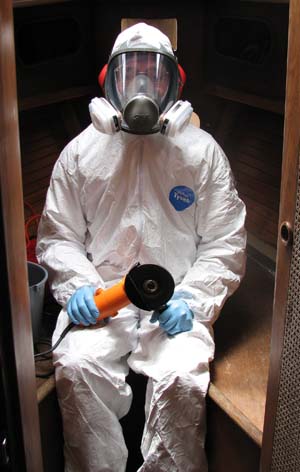Every once in a while, I have to turn my head to the side and shake all the excess brain fluff out of my ear. I also have to clean out all the small info-snippets that have gathered in our traveling notebook. So the following post is sort of like the soup you make after cleaning out the refrigerator.
—
I recently found the receipt for some postcards I bought at Graceland. At the time, I hadn’t noticed the name of the store at the top of the receipt: “Welcome To My World.” Considering that Elvis Presley is dead, I’m wondering, what does that signify?
—
At a Wal-Mart near Bentonville, Arkansas, we had a strange experience. As we walked in, instead of a regular greeter, an older woman walked up to us and said, “Happy Earth Day! Would you like a clothespin?” We accepted this strange gift, on which she’d handwritten, “Save energy! Hang clothes out to dry!”
A day later, checking into a campground, we were handed an 8-1/2×11 sheet of paper, single-spaced, with campground rules. Rule number 13 was, “…use the washers and dryers provided in the laundry room. Clotheslines are very dangerous and things hung outside to dry can blow away in the wind, or be unsightly to other campers.” (the emphasis is theirs) Laughing, Barry clipped the rules sheet to our notebook with the clothespin, leaving me to ruminate on the paradox.
—
Favorite street names: Side Street, Friendly Street, Liberal Avenue. The first two were in Eugene. The third one could have been, but wasn’t.
—
Favorite billboards: Two checkboxes, reading “Stick head in sand” and “Fight global warming.”
And: Lose 3000 pounds in one day! Donate your car to…
And: Be an Oklahoma State Trooper — company car provided!
—
Most common question from strangers on our trip across the country: “Is that a boat?”
Answer most likely to be met with a chuckle: “Yep, my wife built it.”
—
I put a magnetic peace sign on the back of our van, my quiet statement about the Iraq war. However, I was confused, and I put it on upside-down, with the three prongs up. My sister, who also has one, laughed at me, but I still wasn’t absolutely certain that she was right. After I’d seen at least six peace signs along I-5, all of them with the prongs down, I flipped it over, embarrassed. How could I have lived through the 70’s and not noticed?
—
Funniest missing comma: “This road adopted by Wal-mart Marina.”
—
Funniest Texas sign: “Don’t mess with Texas. Up to $2000 fine for littering.”
—
Strangest highway equipment: On Highway 1, along the California coast, rockslides are so common that they use something like a snowplow to clear the roads. We dubbed them “rockplows.”
—
Favorite exit signs: “Santa Claus Lane, next exit.”
Also, “Mexico, next exit.” Don’t you wonder what the one on the other side says?
—
Best question on a billboard: “Have you ever met an honest mortician?”
—
Three great business names: HAYKINGDOM, Insane Autos, Aggressive Towing
—
If cows could read, and if they appreciated fine wrought-iron work, maybe the lovely archway that says “Cattle Town” over the entrance to the feedlot would make them think they’re going to a nice place. I doubt it, though.
—
Weirdest church name: Bovina United Methodist Church (I bet the sermons are very mooooving!)
—
Two beautiful California things I saw firsthand: Fields of purple artichokes and whales spouting in the Pacific Ocean.
—
Not an April fools’ joke: On April 1, 2008, we stopped at 1 Infinite Loop Drive, also known as Apple Headquarters. This was not to pay homage to the maker of our new computer, but to have lunch with Todd, who we’d not seen in 17 years. He looks exactly like he did when he graduated from college, one advantage to losing one’s hair young.
—
Dumb question, smart answer: Driving through Arizona date country, Meps asked, “If dates come from palm trees, and coconuts come from palm trees, are dates related to coconuts?” Barry answered, “As much as peaches are related to oranges, I guess.”
—
Friona, Official Cheeseburger Capital of Texas.
Twenty miles later: Welcome to Hereford, Beef Capitol of the World. Sorry, the folks in Friona say it only counts if it’s official.
—
Most propitious lunch stop: We received an email in February from our friend, Drew, that read “Rudy’s BBQ is a must stop. All other BBQ including Mary’s (his wife, rumored to make the best homemade BBQ in Seattle) is judged by this Texas Standard.” Two months later, we happened to be passing Rudy’s, outside El Paso, precisely at lunchtime when our stomachs were growling.
—
In Oregon, where all gas is pumped by attendants, we started chatting with the man pumping our diesel. He asked where we were headed, and when we told him “North Carolina, via San Diego” he told us about a trip he once took. They drove from Grant’s Pass to Charleston, South Carolina and back, over 6000 miles, in 5 days. He seemed proud to have “seen” the entire USA.
Since we purchased the Squid Wagon in Florida and took it to Seattle by way of Newfoundland, our trusty Ford van has not crossed the USA, it has actually circumnavigated it. Compared to the fellow from Grant’s Pass, though, we’re slow. We’ve only traveled twice the distance, or 12,000 miles. But it took us four and a half months for the northern leg, and a speedy five weeks for the southern.

 I’ve had much better times in a different bunny suit…and Meps had a
I’ve had much better times in a different bunny suit…and Meps had a